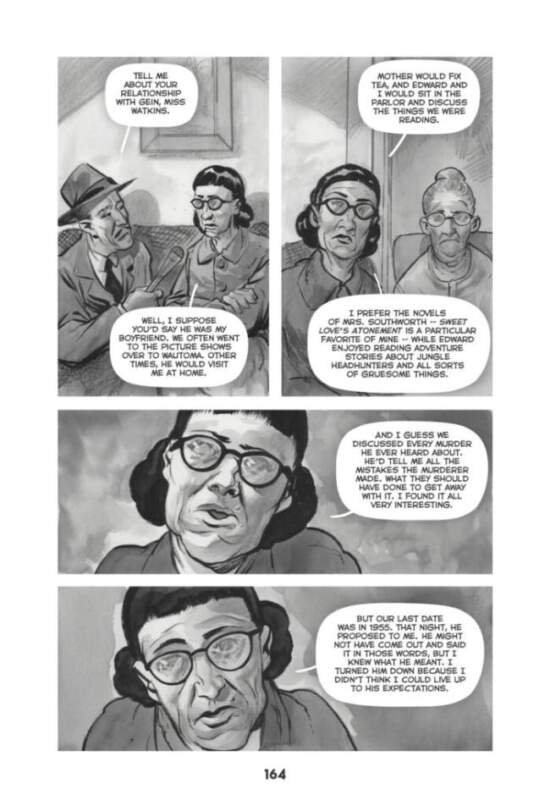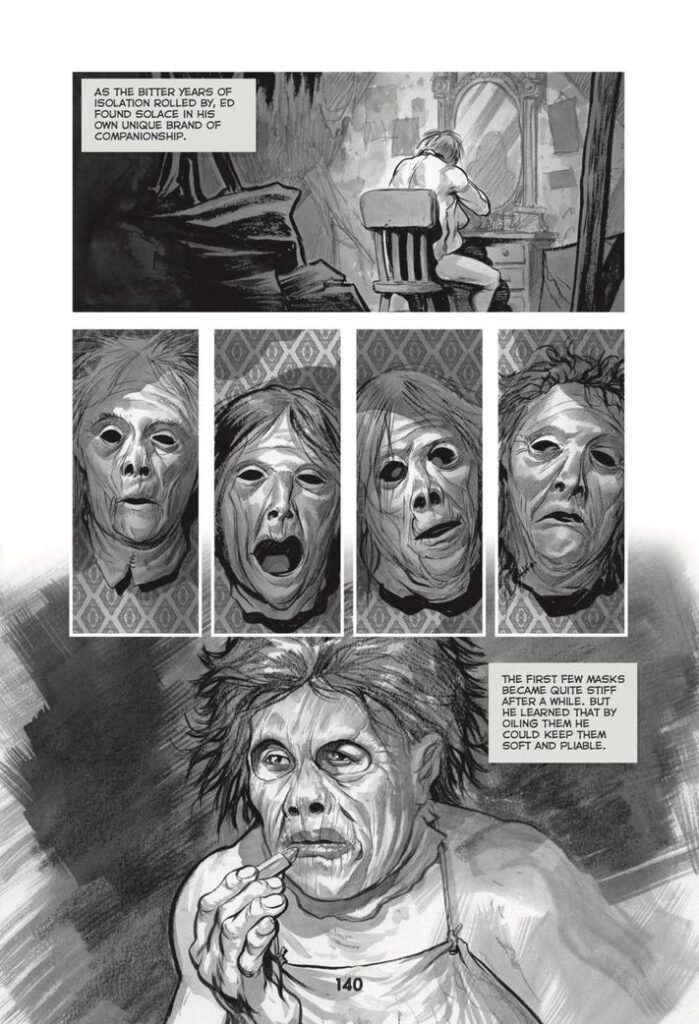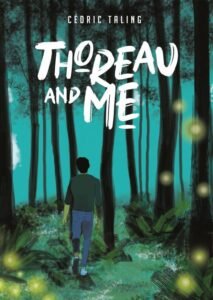Writers : Harold Schechter & Eric Powell
Artist : Eric Powell
Design : Phil Balsman
Publisher : Albatross Funnybooks
Year : 2021
Throwing up, as an action, requires the body to respond to a situation which, theoretically, has become unbearable. There might be endless tales of when, after drinking too much, we could have accidentally, quite naturally, felt the urge to discharge that amount of alcohol that was starting to stop our body from functioning properly. Yet, this would be half the story. Vomit is caused, among the aforementioned act of self harm, by the impossibility of facing a situation that is, by its very constitution, an insult to life – some horrible thing. But there is something more: We might indeed feel sick in the stomach just by a situation where we perceive something is not at all right, as if the lurking feeling that crawls on the back of our neck is not lying there for nothing. Something is wrong, we know it, although not too consciously.
Throwing up is something we may want to do while reading Professor Harold Schechter and Eric Powell’s graphic novel. There is little denying how powerful the book is, haunting us after closing the last page (this would be the bios of the authors, an innocent amount of information). Eddie Gein, one of America’s most infamous serial killers (or, simply put, deranged men), is not a force of nature we can easily forget, nature being here the plethora of psyches that are produced inside the walls of humanity (some are brilliant, some are average, and some are simply impossible to categorize).

Whatever Gein was is not something that can be deduced from these pages, and this is not because there is something missing, rather because the man himself was impossible to decipher. Was he a victim of events, or was he inherently evil? Evil is here taken as an abstract element that is linked to hurting and harming people without a rational justification. Justification for murders can follow an internal logic, and therefore appear rationally conclusive?
The question is asked right at the beginning, the first pages presenting us Alfred Hitchcock as he talks about one of his masterpieces, Psycho, based on a book by Bloch inspired by Gein’s life. What is it that makes a man what he is? Is it nature, is it nurture, is it a bit of both? It would be easy to dismiss the problem as non-existent, as too mired in the impossibility of reaching a clear answer.
But it is not the solution that we should be looking for, rather what the matter entails. If society bears the burden of creating citizens, then society is always to blame for the rise of elements with antisocial and harmful tendencies. A beautiful option, this one, as it allows for the idea that by perfecting the education of men and women we can reach the goal of producing the best human beings that Earth could ever hope to give birth to.
It is the other option, then, that disturbs us: if nature is such that people are born the way they are, this means insanity is not a controllable factor and so, if gone undetected, it can create anomalies in the normal course of human life. Killers are killers because they are born evil; good luck trying to spot them before they rip your guts open.
In the end, the Gein we are being presented with in this superb novel is not a character we can understand, at least not regarding the motives behind his abhorrent conduct. What does the fact that he denies killing people mean, even when there is so much evidence pointing to his being obviously guilty?
It is here that the book shines even more, not just thanks to the impossibly masterful strokes of artist Eric Powell’s pencil, but also by not giving us a straight answer: surely, we are given an interpretation of what might have happened in those moments when nobody was present, but, at the same time, there is no final judgment being uttered by the two writers.
The unmistakable feeling of sickness as we read through the pages is not the result of cheap effects, where graphic imagery reigns over anything else; indeed, the art is such that even those gruesome details that Gein’s house used to keep inside its belly are given with a matter-of-fact-ness that makes the general tone more poignant than could have possible have been.

Sickness exudes from the pages exactly because we are led to face horror in the face, a kind of horror that shows how, when compared to the cold laws of the universe, whether a man kills out of pleasure or simply because he feels like it, it all means nothing.
Born in 1948, Professor Schechter https://haroldschechter.com/ has written extensively about deranged criminals, both as true crime stories and as fiction. We are honoured to have him answer a few questions about the book and its infamous protagonist.
1) In Chapter 1, Hitchcock tells a journalist that thinking that a killer has been inspired by a work of art does not mean much: it is the evil that already dwells inside that person that matters. This is a strong statement which also works as a caveat for the graphic novel. Can we say, then, that evil is a universal feature we are born with, and that there isn’t much we can do to stop it, unless we work as a society to find the deranged elements and confine them in a place where they cannot harm anybody?
I would say that violent aggression is an innate component of the human soul. As C. G. Jung puts it, we all have an unacknowledged “Shadow” side that revels in the taboo and socially unacceptable (the philosopher William James called it the “carnivore within”). Most of us satisfy that primitive part of ourselves by indulging in the vicarious pleasures of things like gory horror films . . . or true crime stories. Unfortunately, there are some people in whom the socialization process breaks down and who act out their darkest , most sadistic fantasies. Those people should obviously be incarcerated.
2) At first, when reading about his boyhood, we are led to feeling sorry for Ed Gein. Yet, once we reach the end of the novel, especially page 206, the only thing that’s left for us is disgust. Is it possible to say that there is a limit which, once we cross it, pity must be abandoned? How much weight should traumas have, in such cases, and how much should a person be asked to take his or her responsibilities?
I agree. When you look at the backgrounds of many serial killers, you find that they suffered terrible abuse and humiliation in their childhoods. It’s possible to feel pity for them for the torture they endured in their pasts without in any way feeling sympathy for the creatures they become.
3) Would it be right to call Gein a monster? Is he really someone who has abandoned humanity to become part of something which lies far away from our society, or is he part of what makes humankind what it is? Is the book about us or is it about a foreign element?
I don’t think of Gein as monster, certainly not in comparison to sadistic lust-murderers like Albert Fish, John Wayne Gacy, or Ted Bundy. He was essentially a necrophile. The bulk of his victims were already dead and buried before he performed his mutilations on their bodies. To be sure, he murdered two women–a heinous crime. But even then, he was not interested in torturing them, unlike the aforementioned serial killers. He executed them swiftly in order to use them as the “raw material,” as it were, for his necrophiliac actives.
4) On pages 162 and 163 we are put in front of Ed Gein becoming an urban legend. Not all that is told about him, then, is true, although this means that not all is false. How did you approach the graphic novel, then? How realistic would you say it is?
The graphic novel draws from my deeply researched book Deviant. It is completely fact-based, with the exception of the professor of religion who, towards the end, offers a theory about the sources of Gein’s madness and who serves as a vehicle for conclusions about Gein’s psychopathology that I have arrived at since the publication of my book.
5) In Chapter 11, Professor O’Hara explains your theory regarding the possibility that Gein’s mother had become a sort of deity to her son. If taken as a metaphor for Gein’s deranged mind, the effect is such that we do not feel intimidated, yet, if taken as proof that Gein’s was not something peculiar, that his was not a case never to be repeated, this means that he was simply acting out a primordial need that is part and parcel of humanity (or, at least, of part of humanity). Your theory, so it seems to me, destabilizes our preconceptions of what a serial killer is. Is our idea of progress and civilization, something we derive from ancient Greece (with its us-civilized and them-uncivilized dichotomy), a blatant lie we tell ourselves?
First, I don’t consider Gein a serial killer, for reasons I explain above. As for your question, I believe that, while we have certainly made enormous advances in our evolutionary history and are far more civilized than, say, the medieval peasants who turned out by the thousands to watch a prisoner be drawn-an-quartered or burned alive, we retain an atavistic savagery that requires an outlet. A lot of popular culture exists for just that purpose, which is pretty much why it consists primarily of sex and violence. Unfortunately, there are–and will probably always be–people in whom, for whatever reasons of upbringing, neurological damage, etc., those primordial impulses erupt with frightening results. Devoid of the inhibitions and moral conscience that keep the rest of us on the straight and narrow, they act out the savagery we have inherited from our primate ancestors. To paraphrase Plato, the wicked man does what the virtuous man only dreams.

